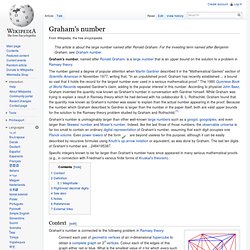

Graham's number. Graham's number, named after Ronald Graham, is a large number that is an upper bound on the solution to a problem in Ramsey theory.

The number gained a degree of popular attention when Martin Gardner described it in the "Mathematical Games" section of Scientific American in November 1977, writing that, "In an unpublished proof, Graham has recently established ... a bound so vast that it holds the record for the largest number ever used in a serious mathematical proof. " The 1980 Guinness Book of World Records repeated Gardner's claim, adding to the popular interest in this number.
According to physicist John Baez, Graham invented the quantity now known as Graham's number in conversation with Gardner himself. While Graham was trying to explain a result in Ramsey theory which he had derived with his collaborator B. Knuth's up-arrow notation. In mathematics, Knuth's up-arrow notation is a method of notation for very large integers, introduced by Donald Knuth in 1976.[1] It is closely related to the Ackermann function and especially to the hyperoperation sequence.

The idea is based on the fact that multiplication can be viewed as iterated addition and exponentiation as iterated multiplication. Continuing in this manner leads to iterated exponentiation (tetration) and to the remainder of the hyperoperation sequence, which is commonly denoted using Knuth arrow notation. Introduction[edit] The ordinary arithmetical operations of addition, multiplication and exponentiation are naturally extended into a sequence of hyperoperations as follows. Multiplication by a natural number is defined as iterated addition:
Future of an expanding universe. Peloton. The peloton during the 2005 Tour de France.

Clustering of the teams is apparent. The term is also used to refer to professional cyclists in general. Definition[edit]